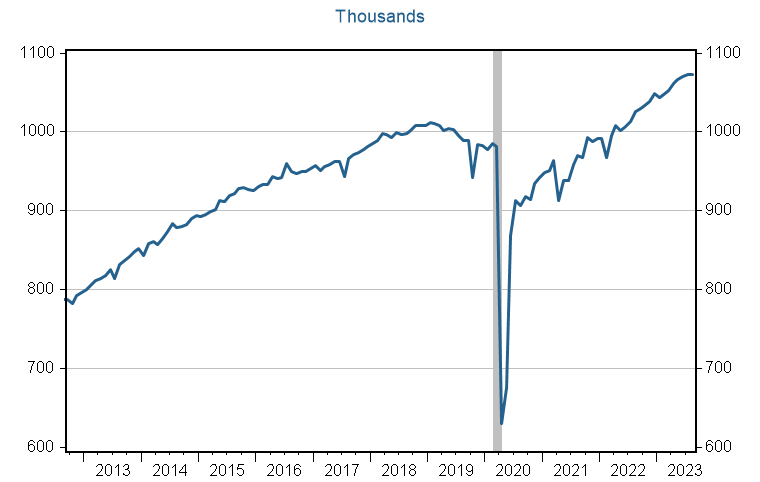Seeing an electric car roll by was once a remarkable event. Today, it’s common to see several electric cars during your commute and even one or two charging in the parking garage at work. Electric vehicles have become such a part of everyday life that they are even playing a role in the current United Auto Workers strike.
In the past 10 years, the number of battery electric vehicles (BEVs) on U.S. roads has grown from fewer than 100,000 in 2012 to over 2.1 million in 2022.1 The share of BEVs and plug-in hybrids (PHEVs) in light vehicle sales has grown from near zero in 2013 to about 5% in 2022.2 These trends are expected to accelerate, with forecasts that 50% of vehicles on the road in 2040 will be electric vehicles.3
While preferences toward environmentally friendly and exhilarating acceleration play a role, policies provided by the federal and some state governments incentivizing car manufacturers to produce more electric vehicles and their parts inside the U.S. are driving demand. To make the new BEVs, car manufacturers are building factories in new locales, expanding existing ones and hiring additional workers. In some cases, existing models of traditional internal combustion engine vehicles are being discontinued, and their assembly lines are being updated and retooled for the new BEVs. An industrywide transition is underway in the automotive manufacturing industry, as manufacturers commit tens of billions of dollars of capital investment in BEV and the production of their batteries.
How Important Is the Automotive Manufacturing Industry?
U.S. Motor Vehicles & Parts Manufacturing Employment

Electric vehicles are having and will continue to have a significant impact on automotive manufacturing. As of August 2023, the vehicle industry employed 1.1 million workers in the U.S. The number is up by more than 33% from 2013, more than double the pace of national job creation, and the automotive industry was the fastest-growing manufacturing sector.4 At the same time, motor vehicle and parts manufacturing created $183 billion and made up 6.3% of manufacturing output and 0.7% of total U.S. output.5
Most of these factories and assembly lines are in “Auto Alley,” an area stretching from the Great Lakes down to the Gulf Coast. Any shifts in the industry, good or bad, will thus have meaningful impacts on both the regional economies that rely significantly on these plants and the U.S. economy as a whole.6
A Double-Edged Sword
There are two perspectives to this electrifying transition. On one hand, the increasing demand for electric cars is creating new opportunities for jobs and innovation in new locations. Toyota has started constructing a battery factory in the Greensboro Extended Metropolitan Area (EMA) for its BEVs and PHEVs in Randolph County, North Carolina, and has announced it is investing $3.79 billion in the project.7 This is the second auto factory in the Greensboro area, after the longtime Thomas Built bus factory in High Point. It’s also the first of two major BEV-projects landed by North Carolina, in addition to the $4 billion VinFast manufacturing center project in Chatham County, about an hour southeast of Greensboro.8
On the other hand, the increased demand for BEVs could have a deleterious impact on overall auto sector jobs. That’s because internal combustion engine vehicles are composed of more parts, and their powertrains are more complicated to produce and install than those of BEVs. The relative simplicity of assembling a BEV and the fewer parts used in its production have led some to predict there would be a net loss for car manufacturing jobs.9 This possibility is one of the main drivers of the UAW strike and it has shaped workers’ demands in negotiations with the auto manufacturers.10
But this is not assured. Some researchers point to the fact that certain parts on BEVs require a great deal of labor to manufacture, specifically the battery, and think BEVs may need even more labor hours overall to produce.11
An Opportunity for Some and an Uncertain Future for Others
For now, the heavy investment in electric car manufacturing, and especially battery manufacturing, is an opportunity for regional economies to attract large automotive employers. Toyota’s previously mentioned battery factory will be a significant economic gain for Randolph County. With a population of just 140,000, the county has a workforce of about 65,00012, and the 2,100 additional jobs from the new plant would directly increase its workforce by 3.2%. If the factory were open today, Toyota would be the largest single employer in the county and the median wage that would be paid to the factory workers of about $62,00013 is 34% higher than the county’s current median salary.14
Moreover, the spillover effects could be significant as these jobs would increase demand for service-industry businesses such as restaurants and potentially create additional jobs in the region. Research suggests that for every one motor vehicle manufacturing job created, about 14 indirect jobs are created through the demand for suppliers and spending in the local economy. For battery manufacturing, the multiplier is smaller but still positive at 2.8 indirect jobs created.15
Thanks to the new plant, the transition to electric cars provides Randolph County and the Greensboro EMA promise for the future. For other EMAs, such as Spartanburg, South Carolina, and Tuscaloosa, Alabama, the electric transition represents an uncertain future. These EMAs are home to BMW and Mercedes-Benz plants, respectively, that opened in the 1990s. In the short to medium term, these areas may see a rise in employment from electric vehicle manufacturing. In the long term, the automotive manufacturing jobs in these areas could decrease if electric cars do prove to need less labor to manufacture and assemble.
1 IEA. (2023). Global EV Outlook 2023. IEA. https://www.iea.org/reports/global-ev-outlook-2023
2 The Economist (2023, April 16). How Japan is losing the global electric-vehicle race. The Economist. https://www.economist.com/asia/2023/04/16/how-japan-is-losing-the-global-electric-vehicle-race
3 Buckberg, E. (2024, July 24). The EV Transition Makes the U.S. Economy More Resilient. Kenan Institute of Private Enterprise. https://kenaninstitute.unc.edu/commentary/the-ev-transition-makes-the-u-s-economy-more-resilient/
5 Bureau of Economic Analysis (Output shares are calculated as Motor vehicles, bodies and trailers, and parts Manufacturing Gross Value Added divided by Total-Manufacturing GVA and US GDP respectively, dollar values are reported at an annualized rate). Note: some articles, such as the one in the following link report motor vehicle output as 3% of GDP.
6 For more information on overall regional manufacturing trends see https://kenaninstitute.unc.edu/kenan-insight/manufacturing-regional-strengths-and-shifts/
7 Stradling, R. (2023, August 28). Toyota says it will add hundreds of workers to North Carolina car battery plant. The News & Observer. https://www.newsobserver.com/news/business/article265151821.html
8 Jacobs, R. (2022, March 30). North Carolina is getting its first car manufacturing plant. Here’s what you need to know. WUNC. North Carolina is getting its first car manufacturing plant. Here’s what you need to know | WFAE 90.7 – Charlotte’s NPR News Source
9 Eisenstein, P. A. (2019, October 3). Electric vehicles pose ‘real risk’ for autoworkers, with fewer parts — And jobs — Required. NBC News. https://www.nbcnews.com/business/autos/electric-vehicles-pose-real-risk-autoworkers-halving-number-people-required-n1060426
10 Kaye, D. (2023, September 20). Why the UAW is fighting so hard for these 4 key demands in the auto strike. NPR. Why the UAW is fighting so hard for these 4 key demands : NPR
11 Cotterman, T., Fuchs, E. R., & Whitefoot, K. (2022). The transition to electrified vehicles: Evaluating the labor demand of manufacturing conventional versus battery electric vehicle powertrains. SSRN.
13 Doyle, S. (2021, December 6). Toyota’s first product at Greensboro-Randolph Megasite: Everyone is happy how the deal worked out. Fox 8. Retrieved September 19, 2023. https://myfox8.com/news/north-carolina/piedmont-triad/toyotas-first-product-at-greensboro-randolph-megasite-everyone-is-happy-how-the-deal-worked-out/
15 Bivens, J. (2019, January 23). Updated employment multipliers for the U.S. economy. Economic Policy Institute. https://www.epi.org/publication/updated-employment-multipliers-for-the-u-s-economy/

Electric Vehicles: New Cars, New Regions and New Challenges